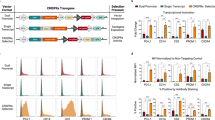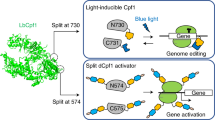Abstract
Genome editing technologies can be diverted into artificial transcription activators. In particular, researchers have improved dCas9-based technologies by tandem-fusing or trans-accumulating effector domains. Previously, we developed a hierarchical effector accumulation system named “TREE,” enabling robust activation of target genes even when strongly silenced. In this chapter, we describe our protocol to design, construct, and validate the TREE-mediated target gene activation in cultured human cells.
Access this chapter
Tax calculation will be finalised at checkout
Purchases are for personal use only
Similar content being viewed by others
References
Kim YG, Cha J, Chandrasegaran S (1996) Hybrid restriction enzymes: zinc finger fusions to Fok I cleavage domain. Proc Natl Acad Sci U S A 93:1156–1160. https://doi.org/10.1073/pnas.93.3.1156
Miller JC, Tan S, Qiao G, Barlow KA, Wang J, Xia DF, Meng X, Paschon DE, Leung E, Hinkley SJ, Dulay GP, Hua KL, Ankoudinova I, Cost GJ, Urnov FD, Zhang HS, Holmes MC, Zhang L, Gregory PD, Rebar EJ (2011) A TALE nuclease architecture for efficient genome editing. Nat Biotechnol 29:143–150. https://doi.org/10.1038/nbt.1755
Gilbert LA, Larson MH, Morsut L, Liu Z, Brar GA, Torres SE, Stern-Ginossar N, Brandman O, Whitehead EH, Doudna JA, Lim WA, Weissman JS, Qi LS (2013) CRISPR-mediated modular RNA-guided regulation of transcription in eukaryotes. Cell 154:442–451. https://doi.org/10.1016/j.cell.2013.06.044
Kunii A, Yamamoto T, Sakuma T (2020) Various strategies of effector accumulation to improve the efficiency of genome editing and derivative methodologies. In Vitro Cell Dev Biol Anim 56:359–366. https://doi.org/10.1007/s11626-020-00469-y
Gilbert LA, Horlbeck MA, Adamson B, Villalta JE, Chen Y, Whitehead EH, Guimaraes C, Panning B, Ploegh HL, Bassik MC, Qi LS, Kampmann M, Weissman JS (2014) Genome-scale CRISPR-mediated control of gene repression and activation. Cell 159:647–661. https://doi.org/10.1016/j.cell.2014.09.029
Chakraborty S, Ji H, Kabadi AM, Gersbach CA, Christoforou N, Leong KW (2014) A CRISPR/Cas9-based system for reprogramming cell lineage specification. Stem Cell Rep 3:940–947. https://doi.org/10.1016/j.stemcr.2014.09.013
Garcia-Bloj B, Moses C, Sgro A, Plani-Lam J, Arooj M, Duffy C, Thiruvengadam S, Sorolla A, Rashwan R, Mancera RL, Leisewitz A, Swift-Scanlan T, Corvalan AH, Blancafort P (2016) Waking up dormant tumor suppressor genes with zinc fingers, TALEs and the CRISPR/dCas9 system. Oncotarget 7:60535–60554. https://doi.org/10.18632/oncotarget.11142
Chavez A, Tuttle M, Pruitt BW, Ewen-Campen B, Chari R, Ter-Ovanesyan D, Haque SJ, Cecchi RJ, Kowal EJK, Buchthal J, Housden BE, Perrimon N, Collins JJ, Church G (2016) Comparison of Cas9 activators in multiple species. Nat Methods 13:563–567. https://doi.org/10.1038/nmeth.3871
Chavez A, Scheiman J, Vora S, Pruitt B, Tuttle M, Iyer E, Kiani S, Guzman C, Wiegand D, Ter-Ovanesyan D, Braff J, Davidsohn N, Weiss R, Aach J, Collins C, Church G (2015) Highly-efficient Cas9-mediated transcriptional programming. Nat Methods 12:326–328. https://doi.org/10.1101/012880
Konermann S, Brigham MD, Trevino AE, Joung J, Abudayyeh OO, Barcena C, Hsu PD, Habib N, Gootenberg JS, Nishimasu H, Nureki O, Zhang F (2015) Genome-scale transcriptional activation by an engineered CRISPR-Cas9 complex. Nature 517:583–588. https://doi.org/10.1038/nature14136
Tanenbaum ME, Gilbert LA, Qi LS, Weissman JS, Vale RD (2014) A protein-tagging system for signal amplification in gene expression and fluorescence imaging. Cell 159:635–646. https://doi.org/10.1016/j.cell.2014.09.039
Kunii A, Hara Y, Takenaga M, Hattori N, Fukazawa T, Ushijima T, Yamamoto T, Sakuma T (2018) Three-component repurposed technology for enhanced expression: highly accumulable transcriptional activators via branched tag arrays. CRISPR J 1:337–347. https://doi.org/10.1089/crispr.2018.0009
Sakuma T, Nishikawa A, Kume S, Chayama K, Yamamoto T (2014) Multiplex genome engineering in human cells using all-in-one CRISPR/Cas9 vector system. Sci Rep 4:5400. https://doi.org/10.1038/srep05400
Sakuma T, Sakamoto T, Yamamoto T (2017) All-in-one CRISPR-Cas9/Foki-dCas9 vector-mediated multiplex genome engineering in cultured cells. Methods Mol Biol 1498:41–56. https://doi.org/10.1007/978-1-4939-6472-7_4
Mohr SE, Hu Y, Ewen-campen B, Housden BE, Viswanatha R, Perrimon N (2016) CRISPR guide RNA design for research applications. FEBS J 283:3232–3238. https://doi.org/10.1111/febs.13777
Naito Y, Hino K, Bono H, Ui-Tei K (2015) CRISPRdirect: software for designing CRISPR/Cas guide RNA with reduced off-target sites. Bioinformatics 31:1120–1123. https://doi.org/10.1093/BIOINFORMATICS/BTU743
Cradick TJ, Qiu P, Lee CM, Fine EJ, Bao G (2014) COSMID: a web-based tool for identifying and validating CRISPR/Cas off-target sites. Mol Ther 3:e214. https://doi.org/10.1038/MTNA.2014.64
Amabile A, Migliara A, Capasso P, Biffi M, Cittaro D, Naldini L, Lombardo A (2016) Inheritable silencing of endogenous genes by hit-and-run targeted epigenetic editing. Cell 167:219–232.e14. https://doi.org/10.1016/J.CELL.2016.09.006
Moses C, Nugent F, Waryah CB, Garcia-Bloj B, Harvey AR, Blancafort P (2019) Activating PTEN tumor suppressor expression with the CRISPR/dCas9 system. Mol Ther 14:287–300. https://doi.org/10.1016/J.OMTN.2018.12.003
Di Chen C, Zeldich E, Li Y, Yuste A, Abraham CR (2018) Activation of the anti-aging and cognition-enhancing gene Klotho by CRISPR-dCas9 transcriptional effector complex. J Mol Neurosci 64:175. https://doi.org/10.1007/S12031-017-1011-0
Acknowledgments
We thank Edanz (https://jp.edanz.com/ac) for editing a draft of this manuscript. This work was funded by Grant-in-Aid for JSPS Fellows (grant# 20J13292) to A.K. and Grant-in-Aid for Early-Career Scientists (grant# 19K16111) to T.S.
Author information
Authors and Affiliations
Corresponding author
Editor information
Editors and Affiliations
Rights and permissions
Copyright information
© 2023 The Author(s), under exclusive license to Springer Science+Business Media, LLC, part of Springer Nature
About this protocol
Cite this protocol
Kunii, A., Yamamoto, T., Sakuma, T. (2023). Design, Construction, and Validation of Targeted Gene Activation with TREE System in Human Cells. In: Hatada, I., Horii, T. (eds) Epigenomics. Methods in Molecular Biology, vol 2577. Humana, New York, NY. https://doi.org/10.1007/978-1-0716-2724-2_15
Download citation
DOI: https://doi.org/10.1007/978-1-0716-2724-2_15
Published:
Publisher Name: Humana, New York, NY
Print ISBN: 978-1-0716-2723-5
Online ISBN: 978-1-0716-2724-2
eBook Packages: Springer Protocols




